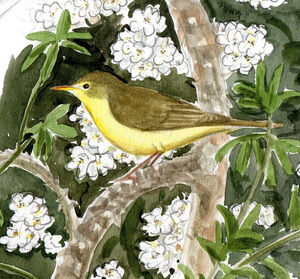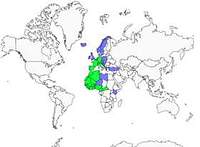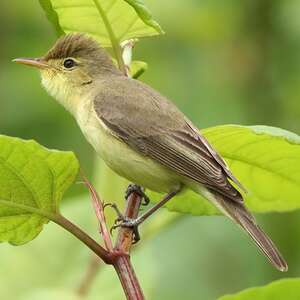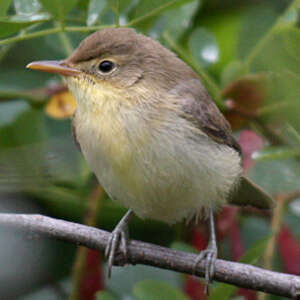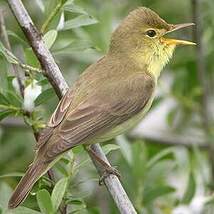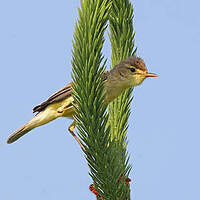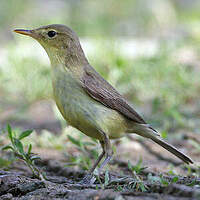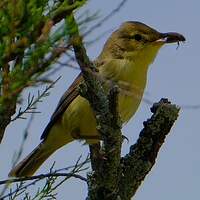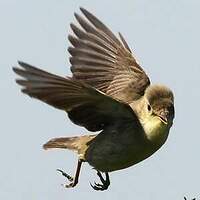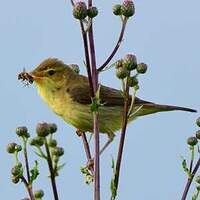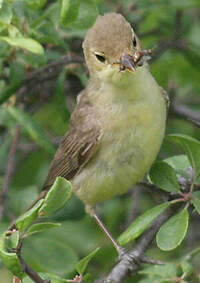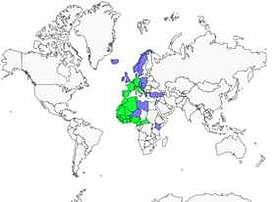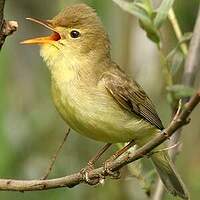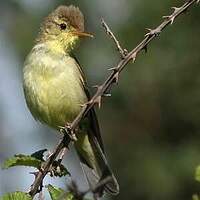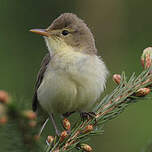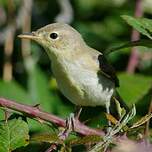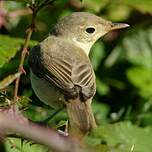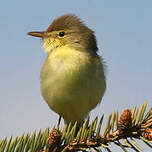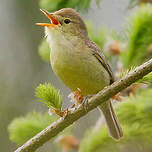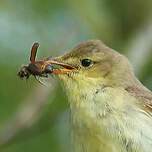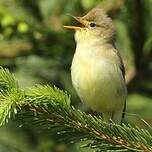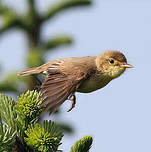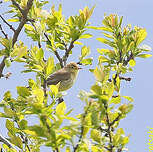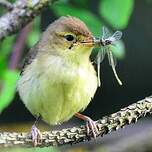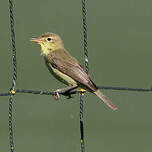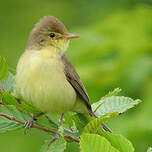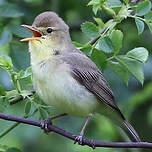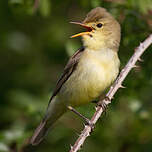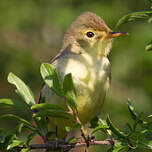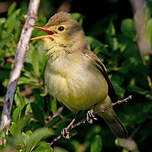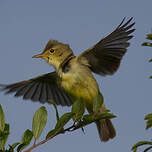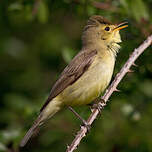Melodious Warbler
Hippolais polyglotta - Hypolaïs polyglotte
Identification
The Melodious Warbler is a medium-sized warbler that stands out mostly by its bright yellow underside in all plumages. The top is quite light brown shaded with yellow or greenish depending on the light, with darker and browner wings and tail. The eye is ringed with yellow. The loral area is yellow, without a dark loral streak, which avoids confusion with, for example, the Chiffchaff. At this level, the edge of the cap is darkened. When the bird sings or is on alert, the front feathers stand up. The beak is quite wide, which is a characteristic of the genus, with the lower mandible yellow-orange. Compared to its lookalike, Icterine (in parentheses), its legs are reddish-brown or gray (blue-gray), the remiges are slightly curled with beige, without a pale area marked on the secondaries (marked pale area) and the primary projection is medium (long). It appears less stocky, with a longer tail.
Subspecific information monotypic species
Foreign names
- Hypolaïs polyglotte,
- Zarcero políglota,
- felosa-poliglota,
- Orpheusspötter,
- déli geze,
- Orpheusspotvogel,
- Canapino comune,
- polyglottsångare,
- Spottesanger,
- sedmohlások štebotavý,
- sedmihlásek švitořivý,
- Spottesanger,
- taiturikultarinta,
- busqueta comuna,
- Skopsöngvari,
- zaganiacz szczebiotliwy,
- daudzbalsu ķauķis,
- kratkoperuti vrtnik,
- Многоголосая пересмешка,
- ウタイムシクイ,
- 歌篱莺,
- polyglottsångare,
- 優音蘺鶯,
Voice song and call
The song of this Melodious Warbler is a long, rather rushed babble, sometimes melodious, sometimes rather grating, starting with the repetition of a simple note and including imitations of the cries of other species (blackbirds, sparrows, swallows, etc.), which earned it the nickname of polyglotte. It is quite different from that of the Yellowhammer, less loud and without the latter's outbursts of voice. The most frequent cry, one of unease, is a rapid succession of notes that is very reminiscent of the call of the Eurasian Tree Sparrow.
Habitat
This species prefers low and open wooded areas, with or without a grassy layer. It can be found in a wide range of environments, from heathlands to abandoned premises which are rapidly reclaiming vegetation, to young forestry, as long as it is in a good sunny and warm spot. In a valley, it will usually prefer the best exposed side. It is often seen along roadsides, railway lines and rivers due to the occasional management which is beneficial to the Melodious Warbler.
Behaviour character trait
The Melodious Warbler is heard more than it is seen on its breeding grounds. But once its song is localized, it is rather easy to find the singer who is not afraid to expose himself at the top of a bush or the end of a branch.
On the other hand, the rest of the species' activity, such as food searching, escapes observation as it takes place within the woody vegetation. When the young have left the nest, one can hear their typical begging peeps, while adults copiously shower the intruder with their insistent alarm calls.Flight
Reproduction nesting
The Melodious Warbler builds its nest at low height (1-4 m), usually in a thick and often prickly bush, like a bramble. It is a light but well-constructed structure, built with dry grass and lined with hair, slightly closed at the top. The female lays 3 to 5 eggs which she incubates for just under two weeks. A second clutch is possible.
Geographic range
The Melodious Warbler has a very western distribution. It is mainly found in France, Spain, Italy and the Maghreb. Its range overlaps little with that of the Eurasian Penduline-tit, more easterly. The contact zone between the two is currently through northern and north-eastern France. The Warbler is progressing northeastward while at the same time, the Penduline-tit is declining and retreating to the east. Its wintering area is in the northwest of Africa south of the Sahara.
Threats - protection
IUCN conservation status
concern
in the Wild
threatened
evaluated
The Melodious Warbler species is increasing both geographically and probably in numbers as well and is currently not endangered. Locally, its protection comes through the protection of bush land that it occupies, but since these are often transitory habitats, the species is adapted to look for new favourable spaces.
Sources of information
- IOC World Bird List (v14.2), Gill, F and D Donsker (Eds). 2024-04-18.
Other sources of interest
 Specification sheet created on
27/07/2023 by Jean François
Specification sheet created on
27/07/2023 by Jean FrançoisTranslation by AI Oiseaux.net
© 1996-2025 Oiseaux.net
- Accipitriformes
- Aegotheliformes
- Anseriformes
- Apodiformes
- Apterygiformes
- Bucerotiformes
- Caprimulgiformes
- Cariamiformes
- Casuariiformes
- Charadriiformes
- Ciconiiformes
- Coliiformes
- Columbiformes
- Coraciiformes
- Cuculiformes
- Eurypygiformes
- Falconiformes
- Galliformes
- Gaviiformes
- Gruiformes
- Leptosomiformes
- Mesitornithiformes
- Musophagiformes
- Nyctibiiformes
- Opisthocomiformes
- Otidiformes
- Passeriformes
- Pelecaniformes
- Phaethontiformes
- Phoenicopteriformes
- Piciformes
- Podargiformes
- Podicipediformes
- Procellariiformes
- Psittaciformes
- Pterocliformes
- Rheiformes
- Sphenisciformes
- Steatornithiformes
- Strigiformes
- Struthioniformes
- Suliformes
- Tinamiformes
- Trogoniformes

